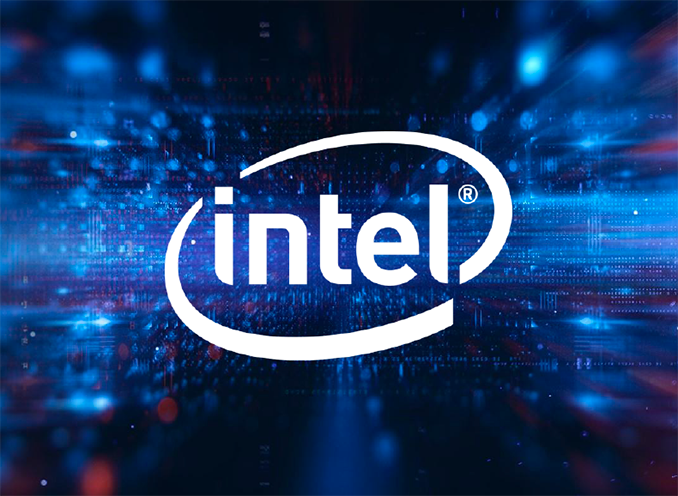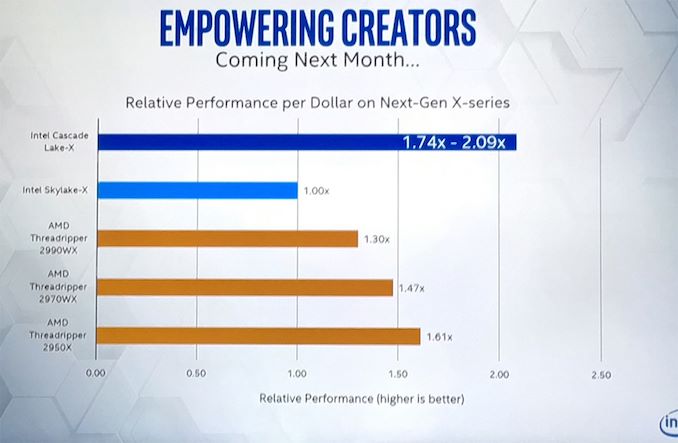Intel’s Next-Generation ‘Cascade Lake-X’ HEDT CPUs Due in October
by Anton Shilov on September 4, 2019 4:00 PM EST- Posted in
- CPUs
- Intel
- HEDT
- Core i9
- Cascade Lake

Intel said Wednesday that its next-generation codenamed Cascade Lake-X processors for high-end desktops will be revealed next month. The company says that the new CPUs will provide a significant boost in performance per dollar when compared to its existing codenamed Skylake-X products, which gives some idea regarding improvements of the chips.
Intel naturally does not disclose specifications of its processors that are at least a month away, so instead it demonstrated a slide showing relative performance per dollar in content creation applications. According to Intel’s internal testing, its Cascade-Lake-X processors will provide a 1.74x – 2.09x relative per-dollar performance improvement when compared to Skylake-X.
Trying to figure out exact core count or price points of Cascade Lake-X CPUs from one performance diagram is certainly not a good business. Meanwhile, from Intel’s launch of its 2nd Generation Xeon Scalable products we know that the company offers either a higher frequency, or more cores at the same price when compared to the prior generation products. So, it is reasonable to expect Cascade Lake-X to provide similar advantages compared to Skylake-X. Also, Intel has launched the Xeon W-3200 series based on Cascade Lake, which will offer some similarity to these parts.
Intel’s Cascade Lake-X processors will use LGA2066 socket and will be compatible with Intel X299-based motherboards with appropriate BIOS and features.
Related Reading:
- Intel’s Enterprise Extravaganza 2019: Launching Cascade Lake, Optane DCPMM, Agilex FPGAs, 100G Ethernet, and Xeon D-1600
- The Intel Second Generation Xeon Scalable: Cascade Lake, Now with Up To 56-Cores and Optane!
- Intel's Basin Falls Skylake-X Refresh: Core i9-9980XE with up to 15% Better Power Efficiency
- Intel Publishes Plans to Wind Down Shipments of 7th Gen Core "Skylake-X" HEDT Processors
Source: Tom’s Hardware











65 Comments
View All Comments
drothgery - Wednesday, September 4, 2019 - link
Though it's likely they'd have more cores at the same price point even if EPYC was kind of meh.nicamarvin - Wednesday, September 4, 2019 - link
Even if Rome had not performance gains, a 64 C/128T 1P Naples would have murked Intel's 9200 Xeons in performance and Price.rahvin - Wednesday, September 4, 2019 - link
The problem is Epyc 2 (Rome) isn't Meh. It's like 20% faster than Epyc 1 and 1/4 the price of a Xeon. You'd have to want to waste money to buy Xeon at this point.Kevin G - Thursday, September 5, 2019 - link
There are still reasons to go with Xeons but they are few and far between. The paradigm has shifted though in that it is easier to select Epyc as the generic default and then exploring your use-case to see if a Xeon platform makes more sense.Irata - Thursday, September 5, 2019 - link
It also depends how they measure performance (cough *Bapco* cough).It is interesting that they stress "performance per dollar" and not absolute performance.
It is probably a combination of higher IPC, more cores, lower price, but as a consumer if you get more for less that is good.
MDD1963 - Wednesday, September 4, 2019 - link
They will offer 40-60% more cores, with a 15% IPC improvement, and a 100 MHz clock speed bump....whatever it takes...and similar prices as before (i.e., still too much!)nicamarvin - Wednesday, September 4, 2019 - link
No Way, No How they can squeeze another 15% IPC from 14++++++ refreshBurntMyBacon - Thursday, September 5, 2019 - link
I think you are confused (or perhaps I am). Better process tech can give us smaller, faster, and cheaper transistors. Assuming the same architecture, this gives us more clock frequency at the same power or lower power consumption at the same frequency (or some combination). Better process tech may have an indirect influence on architecture due to having more transistors to work with, but it is the architectural improvements that give us our IPC gains.Putting aside the process tech, it has been a long time since Intel has introduced a new architecture with a general IPC gain of 15%. That said, I could see them getting a larger gain for specific use cases (I.E. AVX).
AshlayW - Thursday, September 5, 2019 - link
They cannot put Sunny Cove on 14nm++++ or they would have already done it. I suspect it would have very bad perf/watt (vs 7nm Zen2) and require very large dies. Sunny Cove for sure needs more transistors per core to achieve that IPC increase. Also it may very well need more power if it was on the same node.Kevin G - Thursday, September 5, 2019 - link
We may still see Sunny Cove on 14 nm. The back porting takes time and the question is when Intel would have made the decision to back port it. If they thought that the 10nm issues would be short lived, they would have waited it out. Now three years later with a reduction in planned 10nm capacity (due to a fab moving to 14 nm), there is still room for a 14 nm Sunny Cove before 7nm is ready for desktop parts.